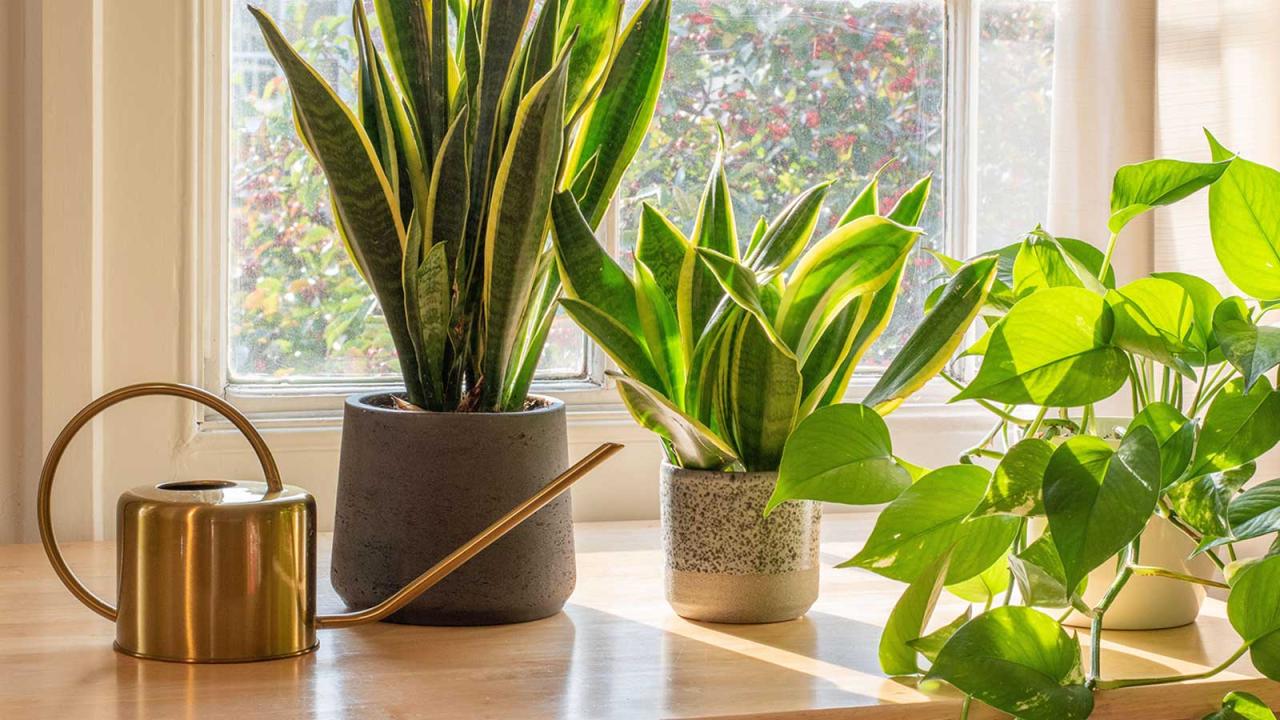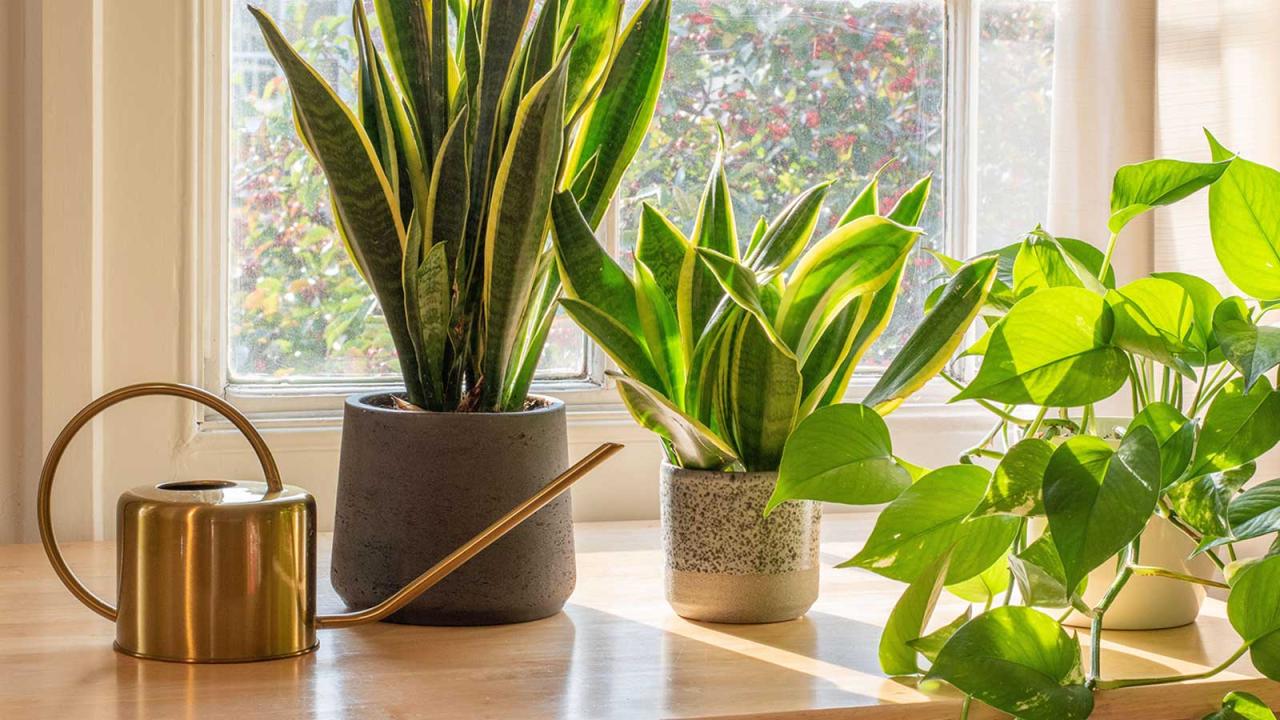Snake Plant Care: How Frequently Should You Water? The answer, as with most things in gardening, is “it depends.” These resilient plants, known for their striking vertical foliage, are surprisingly low-maintenance. However, even a snake plant can suffer from improper watering.
Understanding their unique water storage capacity and the factors that influence their hydration needs is key to keeping your snake plant thriving. This guide will delve into the art of watering snake plants, exploring the optimal frequency and methods to ensure their continued health and beauty.
From analyzing the impact of pot size and material on water retention to understanding the role of seasonality and humidity, this article will provide a comprehensive overview of snake plant watering. We’ll also examine the visual cues indicating a well-hydrated plant, as well as the signs of underwatering and overwatering.
With practical tips and a detailed watering schedule, you’ll be equipped to provide your snake plant with the ideal amount of moisture, ensuring its continued growth and vibrancy.
Factors Affecting Watering Frequency
The watering needs of a snake plant are influenced by various factors, including the size and material of the pot, the season, and the humidity and light exposure of its environment. Understanding these factors is crucial to ensuring the plant receives the right amount of water and thrives.
Pot Size and Material
The size and material of the pot directly impact how much water the snake plant absorbs and retains.
- Pot Size:Larger pots hold more soil, which means more water is required to fully saturate the soil. Conversely, smaller pots dry out faster, requiring more frequent watering.
- Pot Material:Terracotta pots are porous, allowing excess water to evaporate quickly. This makes them suitable for snake plants as they prevent overwatering. Plastic pots, on the other hand, retain moisture longer, potentially leading to root rot if not watered carefully.
Seasonal Variations
Snake plants have different watering needs depending on the season.
- Summer:During summer, when temperatures are high and the plant is actively growing, it requires more frequent watering. The soil should be allowed to dry out slightly between waterings, but not completely.
- Winter:In winter, when the plant’s growth slows down, watering frequency should be reduced. The soil should be allowed to dry out completely before watering again.
Humidity and Light Exposure
Humidity and light exposure also play a role in determining the snake plant’s watering needs.
- Humidity:In humid environments, the soil will dry out more slowly, requiring less frequent watering. Conversely, in dry environments, the soil will dry out faster, necessitating more frequent watering.
- Light Exposure:Snake plants require bright, indirect light. If they are exposed to direct sunlight, the soil will dry out faster, requiring more frequent watering. In low-light conditions, the soil will dry out slower, requiring less frequent watering.
Signs of Proper and Improper Watering: Snake Plant Care: How Frequently Should You Water?

Understanding the visual cues that indicate the hydration status of your snake plant is crucial for its health and well-being. These cues can help you determine if your plant is receiving the right amount of water or if it’s experiencing either underwatering or overwatering.
Signs of Proper Watering
A well-hydrated snake plant exhibits specific characteristics that reflect its healthy state. These visual cues provide a clear indication that your watering routine is suitable for the plant’s needs.
One of the most common questions about snake plant care is how often to water them. The answer depends on a variety of factors, including the size of the plant, the type of pot, and the climate. A good rule of thumb is to let the soil dry out completely between waterings.
For more detailed guidance on the watering process, check out this beginner’s guide: How to Water Snake Plants: Tips for Beginners. By following these tips, you can ensure your snake plant thrives and remains healthy for years to come.
- Firm and Erect Leaves:The leaves of a properly watered snake plant stand upright and feel firm to the touch. This indicates adequate moisture levels within the plant’s tissues.
- Vibrant Green Color:A healthy snake plant displays a rich, deep green color, reflecting its ability to photosynthesize efficiently due to sufficient hydration.
- No Wilting or Drooping:The leaves of a well-hydrated snake plant remain strong and do not show any signs of wilting or drooping, which are common indicators of underwatering.
Signs of Underwatering
When a snake plant is underwatered, it displays specific visual signs that signal a lack of moisture. These cues indicate that the plant is experiencing water stress and requires immediate attention.
- Soft and Flabby Leaves:Underwatered snake plants have leaves that feel soft and flabby to the touch, indicating a loss of turgor pressure due to insufficient water uptake.
- Wilting and Drooping Leaves:The leaves of an underwatered snake plant often wilt and droop, reflecting the plant’s attempt to conserve moisture by reducing its surface area exposed to the environment.
- Brown or Yellow Leaf Tips:Underwatering can cause the tips of the leaves to turn brown or yellow, indicating a lack of moisture and potential damage to the plant’s tissues.
- Slow Growth:A lack of water can significantly hinder the growth rate of a snake plant, as water is essential for various metabolic processes.
Signs of Overwatering
Overwatering is a common problem for snake plants, and it can lead to various issues that may affect the plant’s health and even cause its death. Recognizing the signs of overwatering is crucial for taking corrective measures.
One of the most common questions about snake plant care is how often to water. While these resilient plants can tolerate some neglect, overwatering is a common issue. The amount of light your snake plant receives plays a big role in how often it needs water.
In low light conditions, snake plants require less frequent watering. To learn more about the specific watering needs of snake plants in low light, check out this informative article: How Much Water Does a Snake Plant Need in Low Light?
. Understanding the impact of light on your snake plant’s water requirements will help you maintain its health and keep it thriving.
- Yellowing of Leaves:Overwatering can cause the leaves of a snake plant to turn yellow, indicating that the roots are not receiving enough oxygen due to excessive moisture in the soil.
- Soft and Mushy Leaves:Overwatering can make the leaves feel soft and mushy, indicating that the tissues are becoming waterlogged and potentially rotting.
- Leaf Drop:Excessive moisture can weaken the plant’s structure, leading to leaf drop, especially if the roots are damaged by overwatering.
- Foul Odor:A foul odor emanating from the soil is a strong indicator of overwatering, as it suggests that the roots are rotting due to lack of oxygen.
- Mold Growth:The presence of mold or fungus on the soil surface is a clear sign of overwatering, indicating that the environment is too moist for the plant’s well-being.
Practical Tips for Watering Snake Plants

Watering snake plants effectively involves understanding their unique needs and adjusting your approach based on environmental factors. This section provides practical tips for developing a watering schedule, checking soil moisture, and optimizing watering frequency for optimal plant health.
Developing a Watering Schedule
Creating a consistent watering schedule is crucial for snake plant care. While the general rule is to water when the soil is dry, factors such as pot size, season, and environmental conditions influence the frequency. To design a tailored schedule, consider the following:
- Pot Size:Smaller pots dry out faster than larger ones, requiring more frequent watering. Larger pots retain moisture for longer periods, allowing for less frequent watering.
- Season:During warmer months, snake plants require more frequent watering due to increased transpiration rates. Conversely, in cooler months, their water needs decrease, requiring less frequent watering.
- Environmental Factors:Factors like humidity, temperature, and light levels impact the rate of soil drying. High humidity and temperatures lead to faster drying, while low humidity and cooler temperatures result in slower drying.
Checking Soil Moisture
Accurately assessing soil moisture levels is essential to determine when to water your snake plant. Avoid overwatering by relying on visual cues and tactile methods:
- Visual Inspection:Observe the top layer of soil. If it appears dry and crumbly, it’s likely time to water. If it’s still moist, wait a few days before checking again.
- Finger Test:Insert your finger about an inch deep into the soil. If the soil feels dry, it’s time to water. If it feels moist, wait a few days before checking again.
Optimal Watering Frequency
The optimal watering frequency for snake plants varies depending on the pot size and the season. The table below provides a general guideline for watering frequency:
Pot Size |
Spring/Summer |
Fall/Winter |
|---|---|---|
Small (4-6 inches) |
Every 1-2 weeks |
Every 2-3 weeks |
Medium (8-10 inches) |
Every 2-3 weeks |
Every 3-4 weeks |
Large (12 inches or larger) |
Every 3-4 weeks |
Every 4-6 weeks |
Note:These are general guidelines. Adjust the watering frequency based on your specific environmental conditions and your snake plant’s individual needs.
Common Watering Mistakes and Solutions
Watering a snake plant, while seemingly straightforward, can be a common source of problems for new and experienced owners alike. Overwatering and underwatering are the two most prevalent mistakes, leading to various issues like root rot, stunted growth, and even plant death.
Understanding the reasons behind these mistakes and implementing effective solutions is crucial for ensuring your snake plant thrives.
Overwatering
Overwatering is the most frequent mistake made by snake plant owners, leading to root rot, a condition where roots begin to decay due to excessive moisture. This can be detrimental to the plant’s health, potentially leading to yellowing leaves, wilting, and even death.
- Overwatering Signs:
- Yellowing leaves
- Soft or mushy leaves
- Wilting despite adequate moisture
- Foul odor emanating from the soil
- Causes of Overwatering:
- Frequent watering:Watering too often, even if the soil isn’t completely dry, can lead to waterlogging.
- Improper drainage:A pot without drainage holes or a soil mix that doesn’t allow for proper water runoff can cause the soil to stay waterlogged.
- Excessive humidity:High humidity can make the soil retain moisture for longer, increasing the risk of overwatering.
- Solutions for Overwatering:
- Repotting:If the soil is consistently waterlogged, repotting the snake plant in fresh, well-draining soil is crucial. Choose a pot with drainage holes and ensure the soil mixture contains components like perlite or pumice to improve drainage.
- Allowing the soil to dry completely:Wait until the soil is completely dry before watering again. This might take several days or even a week, depending on the environment and the pot size.
- Reducing watering frequency:Adjust the watering frequency based on the soil’s dryness and the environment. If the soil remains moist for an extended period, reduce the watering frequency to prevent overwatering.
Underwatering, Snake Plant Care: How Frequently Should You Water?
Underwatering, while less common than overwatering, can still cause issues for snake plants. When the soil remains too dry for too long, the plant can become stressed, leading to leaf browning, wilting, and stunted growth.
- Signs of Underwatering:
- Browning leaf tips
- Crispy or dry leaves
- Wilting or drooping leaves
- Stunted growth
- Causes of Underwatering:
- Infrequent watering:Not watering the snake plant often enough can lead to prolonged periods of dryness, causing stress and damage.
- Dry environment:Low humidity or a dry climate can exacerbate the drying effect on the soil, requiring more frequent watering.
- Incorrect pot size:A pot that is too large can lead to the soil drying out quickly, necessitating more frequent watering.
- Solutions for Underwatering:
- Thorough watering:When watering, ensure the soil is thoroughly soaked, allowing the water to drain out of the drainage holes. This ensures the entire root system is adequately hydrated.
- Increasing watering frequency:Increase the watering frequency based on the soil’s dryness and the environment. If the soil dries out quickly, water more often to prevent the plant from becoming stressed.
- Adjusting the pot size:If the pot is too large, consider repotting the snake plant in a smaller pot to help the soil retain moisture for longer.
Proper Watering Technique
Watering snake plants effectively involves more than just pouring water onto the soil. The key is to provide a thorough soaking while allowing excess water to drain, preventing waterlogging.
- Visual Guide:
- 1. Check the soil moisture: Before watering, insert your finger about 2-3 inches into the soil. If the soil feels dry, it’s time to water.
- 2. Water thoroughly: Pour water slowly and evenly onto the soil, allowing it to soak through the entire pot.
- 3. Allow drainage: Let the excess water drain out of the drainage holes. This ensures that the roots aren’t sitting in water.
- 4. Repeat as needed: Repeat this process when the soil dries out again, typically every 1-2 weeks depending on the environment and pot size.
Final Summary

Mastering the art of watering snake plants is a simple yet crucial aspect of their care. By understanding their unique water storage capacity, considering environmental factors, and recognizing the signs of proper and improper hydration, you can cultivate a thriving snake plant.
Remember, consistency and careful observation are key to providing these resilient plants with the perfect balance of moisture, ensuring their long-term health and beauty.
Questions Often Asked
How often should I fertilize my snake plant?
Snake plants are light feeders. Fertilize them once or twice during the growing season (spring and summer) with a balanced liquid fertilizer diluted to half strength.
What kind of soil is best for snake plants?
A well-draining potting mix is ideal. You can use a cactus or succulent mix or create your own by combining potting soil, perlite, and sand.
Do snake plants need direct sunlight?
Snake plants prefer bright, indirect light. Avoid placing them in direct sunlight, which can scorch their leaves.
Can I propagate my snake plant?
Yes! Snake plants can be easily propagated by division or leaf cuttings.
